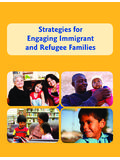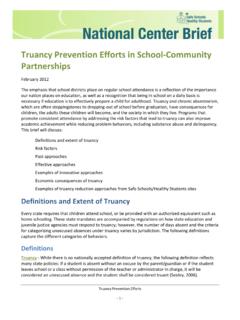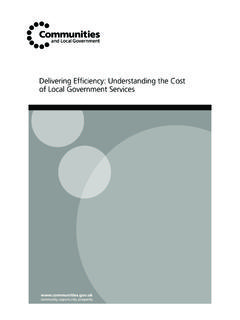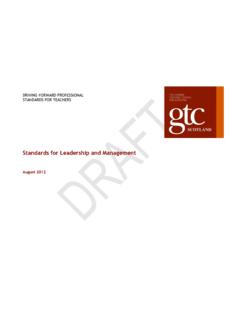Transcription of Leaving a Legacy: Six Strategies for Sustainability ...
1 Leaving a legacy : Six Strategies for Sustainability introduction The enduring work of the Center and its 147 grantees is testament to our vision: together, we can sustain our work, even when grant funding ends. Promoting mental health and preventing youth violence demands that we take the long view-continuously building the support of broad constituencies including parents, mental health providers, schools, juvenile justice, and businesses. The Center is committed to helping grantees leave a legacy by working with them to enhance community collaborations and partnerships, develop staff capacity to implement evidence based programs and lead change, and deepen their understanding of various Strategies to sustain their programs. Our philosophy is to work with leaders, promoting change within a frame of respect and celebration of differences. In the process, we learn from grantees' innovative and creative approaches in their communities and work to connect grantees so that they can learn from each other.
2 Specifically, we focus on six key areas: relationships among community entities such as agencies, coalitions, schools, and parent groups, and between individuals community awareness of mental health or youth violence issues leadership across and within systems the use of evaluation data in decision making staff competencies and expertise and other program capacities funding streams Many equate Sustainability with finding continuing funding for services developed through a grant. However, a broader view of Sustainability entails using various Strategies , represented in the wheel below, to maintain the elements of your program that are responsible for its positive outcomes. Embracing this more complex and comprehensive view can help you sustain program elements and outcomes, whether or not you receive additional funding. Sustainability is a dynamic process. At various points within the grant period, your strategy will change, depending on where you are within your grant period, where you are in thinking through Sustainability goals and plans, and what goals you have set.
3 Published by Articulate Engage 2 Core Layer Our view of Sustainability Our view of Sustainability : Making it happen Projects across the country vary in myriad ways, but all strive toward a shared goal: sustaining their work beyond the initial grant period. Grantees all over the country have found successful Strategies to continue their work meet their goals and marshal their resources. The materials we offer here are culled from their experience and expertise and are designed to be used by project directors or staff members who are perplexed about where to begin or overwhelmed by the array of frameworks, toolkits and other materials currently available. We offer here a comprehensive overview of Sustainability Strategies and resources within a framework that helps you create and develop your own Sustainability work plan. Planning for program Sustainability from the beginning of the grant enhances your chances of success, and visionary leadership will draw collaborators together to meet their common goals.
4 Sustaining a program requires action and Published by Articulate Engage 3 creativity in one or more of 8 possible realms, which are represented in our "wheel": Leadership Partnership and Collaboration Implementation Communications/Marketing Evaluation Financing For each of these Strategies , we offer numerous resources including planning guides, toolkits, and journal articles for in-depth information to help you tailor each type of Sustainability strategy to your circumstances. We believe that Sustainability starts with knowing your overarching goals, seeing which of your program elements are achieving those goals, and being creative about how to keep those elements at play within your community. If the program you implemented achieves the outcomes you were after and is a good fit for the needs of your stakeholders, your long-term Sustainability plan may involve maintaining several program elements.
5 If one or two program elements produced measurable positive results but others did not, your plan may focus on those elements only. The wheel can be used in multiple ways. Clicking on the words within the wheel will take you to a brief explanation of each strategy linked with in-depth resources in each area. Clicking on the words in the outer rim will take you to common questions and answers about Sustainability , definitions of terms, a comparison of leading Sustainability frameworks, and examples of grantee successes. If you are a beginner, try using the wheel like this: Take the self assessment (which surveys activities within each strategy) Explore the definitions to clarify terms Read Spotlight on Grantees for illustrations of Sustainability Explore sections on the wheel to consider what Strategies might work for you If you are moderately experienced , try this: Take the self assessment Read the FAQs Start with wheel sections you are most familiar with Explore wheel sections you have not considered using If you are very experienced , try this.
6 Published by Articulate Engage 4 Look at Models of Sustainability to see a comparison of major models in the field Choose the appropriate wheel section(s) to further develop your Sustainability plan Choose other wheel sections to see if you might add Strategies to your current efforts Layer 1 Leadership for Change Leadership for Change Achieving lasting systemic change requires leaders with vision, skills, and knowledge of how to promote change within systems and communities. Effective, visionary leaders articulate problems and describe solutions to engage a broad base of stakeholders while guiding the decision-making necessary for successful program implementation. Those assuming leadership roles must be able to select and prioritize the changes that will produce positive lasting outcomes and plan for those changes throughout the grant period.
7 Published by Articulate Engage 5 Effective leaders understand that strategic planning is an important tool for identifying the systemic changes that can support an initiative s positive outcomes. Many models of strategic planning exist, and some may be better suited to your circumstances than others; but all strategic planning efforts should include a needs assessment, resource mapping, development of goals and objectives, and implementation timelines. Involving key stakeholders in strategic planning early in your project s life can help Sustainability Strategies emerge and take hold before grant funding expires.
8 An effective strategic planning process will help to identify the goals and objectives that your project and your partner programs share identify ways stakeholders resources can help sustain the work of the initiative and locate opportunities for individual partners to assume ownership of shared functions post-grant embed your project s goals and activities in the community s long-range work make potential supporters---such as policymakers or legislators---aware of your project. Sustaining an initiative s positive outcomes is possible when it s leaders provide a vision of how the project s functions have a place within other community initiatives; identify infrastructure changes that institutionalize practices such as evidence-based curricula or new screening procedures; and connect their work to larger systems ( policy and government agencies) and to groups and individuals within the community who have similar priorities. Fostering such connections can help you tap into the power, passion, and capacity to support your project s activities in the long term.
9 View a resources list of additional links about leadership for change. Published by Articulate Engage 6 Financing Financing Far too often, Sustainability is equated with obtaining additional program funding. Although money may be required to sustain your program's positive outcomes, it is often possible to sustain outcomes with less funding than the original grant provided - and sometimes possible to sustain outcomes with no additional funding. Financial planning will help you identify the resources you need to sustain program outcomes. Non-profits are using an increasing array of revenue-generating Strategies to support previously grant-funded programs. View a resources list of additional links about financing. Published by Articulate Engage 7 Evaluation Evaluation It is important to present your evaluation data and findings to the groups your project serves and those in positions to support your work.
10 Policymakers and stakeholders need to know what problem your program addresses and what evidence you have that the program is working. Presenting key findings from your evaluation can gain your support including funding. Understanding the concerns of stakeholders care about can help you decide what to present. For example, showing a school principal that your program has reduced truancy translates directly into dollars saved and better attendance rates - both of which are important concerns for school administrators. View a resources list of additional links about evaluation. Published by Articulate Engage 8 Partnership and Collaboration Partnerships and Collaboration Partnerships or collaborations among agencies or programs are most effective when connections are established early in a project and cultivated throughout its life cycle. Strong partnerships involve others who are interested in the goals of your project, are affected by the problems you are addressing, and can provide essential support and resources.











